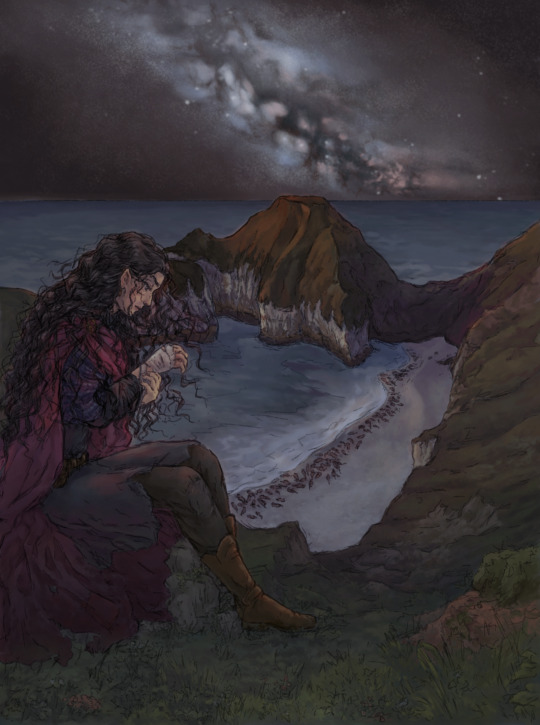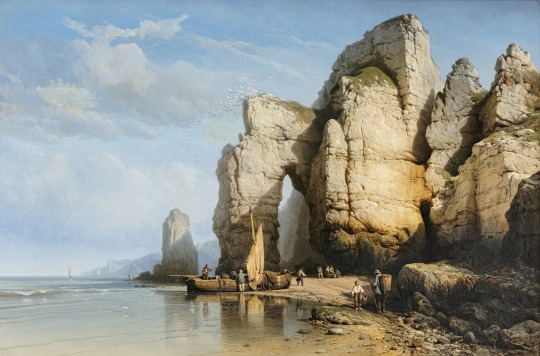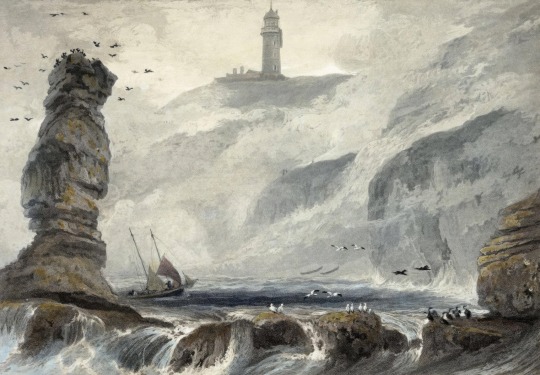#flamborough head
Explore tagged Tumblr posts
Text

Engagement between the Bonhomme Richard and the Serapis off Flamborough Head, 1779, by Richard Willis (1924-)
257 notes
·
View notes
Text


Grey Seals at Flamborough Head, Yorkshire today 05/06/2024
#grey seal#seals#mammals#flamborough head#yorkshire#wildlife#photography#happy#sea#wildlife watching
24 notes
·
View notes
Text




Flamborough Head, June 2024
#england#north york moors#north yorkshire#flamborough head#my pics#holidays#nature#coast#lighthouse#photography
9 notes
·
View notes
Text

This beach belongs to a seal colony; wary of disturbing them, Maglor climbs the rugged cliffs of the headland. Slim chance of finding a good place to settle down for the night here - the ground is rocky and the wind punishing, strong enough to steal the voice even of the Noldor's greatest singer.
He won't sleep, anyway. The pain in his burnt hand lingers, though the wound itself closed up some time ago. (He still keeps it bandaged, so he does not have to look at the mark the Silmaril left behind.) Tonight it flares bright as the myriad stars over the headland. The stars are almost beautiful enough to make up for Maglor's sleeplessness. Perhaps this is why his brother so often took the night watch, in long-ago Himring.
The wind is just as cold.
More of Maglor's Second Age wanderings. Based on a photograph of Flamborough Head in Yorkshire.
#i am incapable of painting coastal landscapes without putting maglor in them#this one comes with writing because i couldn't help myself#maglor#beach hermit maglor#landscape art#landscape#silmarillion#silm art#silm fanart#silmarillion fanart#tolkien fanart#tolkien
623 notes
·
View notes
Text



Yorkshire (2) (3) by GIgaYork
Via Flickr:
(1) Flamborough Head Cliffs (2) Beautiful little church nr Thornton-Le-Dale has a unique grass cutting feature
22 notes
·
View notes
Text

'The Cliffs Of Flamborough Head, Yorkshire'. Charles Joseph Kuwasseg. 1860.
388 notes
·
View notes
Photo

Battle of Flamborough Head
The Battle of Flamborough Head (23 September 1779) was one of the most famous naval engagements of the American Revolutionary War (1775-1783). Fought off the coast of Yorkshire, England, it pitted the USS Bonhomme Richard, commanded by John Paul Jones, against a Royal Navy frigate, HMS Serapis. The engagement was an important victory for the burgeoning Continental Navy.
The Expedition Sets Sail
On 14 August 1779, a small fleet of seven vessels set sail from the port of Groix, France, with the intention of wreaking as much havoc as possible in the British Isles. The Kingdom of France had officially entered the American Revolutionary War the year before as an ally of the fledgling United States and had since provided the Americans with military and financial aid. The French had outfitted the ships for the expedition including the flagship, a 42-gun converted merchant vessel called the Duc de Duras, which was gifted to the United States. The makeshift fleet was under the overall command of Captain John Paul Jones, a Scottish-born officer of the Continental Navy, who had recently won international fame for his daring raid on the English port town of Whitehaven in April 1778.
Prior to sailing, Jones renamed the Duc de Duras to the USS Bonhomme Richard; this was in honor of his friend, Benjamin Franklin, whose celebrated Poor Richard's Almanac was translated into French as Les Maximes du Bonhomme Richard. The other ships under his command included the 36-gun frigate USS Alliance, the 32-gun frigate USS Pallas, the 12-gun corvette USS Vengeance, and the cutter Le Cerf, as well as two privateering vessels, the Monsieur and the Granville. Since the ships were setting sail from France, they were mainly crewed by French sailors (except for the Bonhomme Richard itself) and were captained by French naval officers. After raising anchor on 14 August, the fleet sailed toward the southern coast of Ireland.
Trouble beset the expedition almost immediately. On 18 August, they recaptured a Dutch vessel that had previously been taken by a British privateer. The captain of the Monsieur raided the cargo hold of the captured vessel, taking what he pleased before selecting a prize crew to sail it back to Belgium for sale. Jones overrode these orders, however, putting his own prize crew in place and sending it back to France to be sold in his own name. This enraged the captain of the Monsieur, who felt entitled to the prize. That night, the Monsieur abandoned the fleet with the other privateer, Granville, leaving not long after. Jones was hardly surprised by the disloyalty of the privateers but would soon be faced with more discontent from within his ranks. The aristocratic French naval officers under his command despised taking orders from a provincial, Scottish-born American and were not afraid to show their displeasure; Pierre Landais, captain of USS Alliance, was the most outspoken of this group, flatly telling Jones that he intended to sail Alliance as he saw fit.
After the departure of the privateers, Jones' remaining five ships sailed up around the southwest of Ireland before heading north. In late August, Jones sent Le Cerf to reconnoiter the Irish coast, but the cutter soon became lost; after failing to find its way back to the fleet, Le Cerf turned around and sailed back to France. Jones, meanwhile, continued northward with his remaining ships, sailing along the coast of Scotland. Despite the expedition's rocky start, it finally began to prove profitable, as the Franco-Americans took several British merchant vessels as prizes along the Scottish coast. On 3 September, Jones' fleet rounded the Orkney Islands and turned south. He put a landing party ashore at Leith, the seaport of Edinburgh, with instructions to threaten to burn the port unless the residents paid a large ransom. But before the threat could even be made, a strong gale blew Jones' ships away from the bay, forcing him to call off the raid. Nevertheless, the sight of Jones' fleet off the coast of Scotland was enough to cause panic and alarm throughout Great Britain.
Continue reading...
21 notes
·
View notes
Text



September 23rd 1779 saw the Battle of Flamborough Head.
The Battle of Flamborough Head is one of the most famous events to have taken place in the waters of the North Sea. In 1779 the American War of Independence spread to this unlikely location of on the Yorkshire coast of England
There was a joint Franco-American squadron, attempting to draw the British Home Fleet northwards so a joint Franco-Spanish invasion could take place in the south of England, when happened upon a large British convoy off Flamborough Head. Two Royal Navy ships, vastly outgunned by their French and American foes, saved the convoy, but were captured or sank in the act.
However, the real significance of the battle wasn’t about ships sunk, it became emblematic of the pluck and courage of the fledgling American nation. The American commander John Paul Jones, who was in fact a Scotsman sailing in a French ship, became known as ‘the father of the American Navy’. His ship, the Bonhomme Richard, despite being sunk during the battle, is now a legendary name in American naval history and to this day there is a USS Bonhomme Richard and a USS John Paul Jones serving in the US Navy.
Jone’s ship, USS Bonhomme Richard sank but before it went down he boarded and captured HMS Serapis. During the battle, Jones was famously reputed to have exclaimed “I have not yet begun to fight!” in response to the Royal Navy’s Captain Richard Pearson’s demand that he surrender his ship.
In recent years the wreck of the Bonhomme Richard has been found. It lies beneath the waves of Filey Bay and its discovery could lead to a tourism boom for the Yorkshire coast. The story of this battle is taught to every American schoolchild. It is big history a bit like were taught about........hm, The Battle of Hastings, which had nothing to do with Scotland! Aye well times are changing now and Scottish history is taught a lot more in school than was back in my days.
Scotland has an added interest in the area as on March 22nd 1406 the 8 year old Scottish King, James I, on his way to the safety of France, was captured by pirates off Flamborough Head, and delivered, or “sold” to the then King of England, Henry IV, he did not return home till 1424.
The pics are depictions of the battle, of which there are no shortage online, and a plaque at Filey, near where the Bonhomme Richard sank.
12 notes
·
View notes
Text

Winslow Homer - Flamborough Head, England
17 notes
·
View notes
Photo

Engagement Between the Bonhomme Richard and the Serapis off Flamborough Head, 1779 by Richard Willis
#Richard Willis#ships#sailing#sail ship#sea#meer#wasser#cloudy#boats#american war#ship#yorkshire#watercolour#art#painting#serapis#bonhomme#sun
25 notes
·
View notes
Text
Scarborough to Grimsby
Friday 16th August 2024
Another early start at 06.45 to get out of Scarborough harbour before the tide dropped too much! We made good time along the coast, round Flamborough Head and over the Greenwich meridien so we are now East for the first time in a number of years. Round Spurn Head and into the busy Humber where the VTS kept a close eye on us until we turned into Grimsby Fish Dock to tie up for the night. Lyn from the Little Ship Club joined us for tea on deck in the evening sunshine. Another lovely day!




2 notes
·
View notes
Photo

Bataille de Flamborough Head
La bataille de Flamborough Head (23 septembre 1779) fut l'un des plus célèbres engagements navals de la guerre d'Indépendance américaine (1775-1783). Combattue au large des côtes du Yorkshire, en Angleterre, elle opposa l'USS Bonhomme Richard, commandé par John Paul Jones, à une frégate de la Royal Navy, le HMS Serapis. Cet engagement constitua une victoire importante pour la marine continentale naissante.
Lire la suite...
2 notes
·
View notes
Text




Four of my favourite bird of prey photos this year; Peregrine at Durlston, Dorset in July, Buzzard at Hook-with-Warsash, Hampshire in March, Osprey at Lossiemouth, Moray in April and Short-eared Owl at Flamborough, Yorkshire in June.
#short-eared owl#peregrine#osprey#buzzard#peregrine falcon#hook-with-warsash#hampshire#durlston#dorset#moray#lossiemouth#flamborough head#flamborough#flamborough north landing#yorkshire#england#scotland#uk#birds of prey#bird of prey#2024
7 notes
·
View notes
Text

Lighthouse at Flamborough Head (William Daniell, 1822)
14 notes
·
View notes
Text











Flamborough Head Lighthouse and Bay, Yorkshire, Summer 2009
4 notes
·
View notes
Text

'The Cliffs of Flamborough Head, Yorkshire' (1860) by Austrian painter Karl Joseph Kuwasseg
2 notes
·
View notes